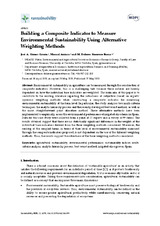Building a Composite Indicator to Measure Environmental Sustainability Using Alternative Weighting Methods
Autor
Gómez-Limón, José A.
Arriaza, Manuel
Guerrero Baena, María Dolores
Editor
MDPIFecha
2020Materia
Agricultural sustainabilityEnvironmental performance
Sustainability indices
Multi-criteria analysis
Analytic hierarchy process
Best-worst method
Irrigated olive groves
Spain
METS:
Mostrar el registro METSPREMIS:
Mostrar el registro PREMISMetadatos
Mostrar el registro completo del ítemResumen
Environmental sustainability in agriculture can be measured through the construction of composite indicators. However, this is a challenging task because these indexes are heavily dependent on how the individual base indicators are weighted. The main aim of this paper is to contribute to the existing literature regarding the robustness of subjective (based on experts’ opinions) weighting methods when constructing a composite indicator for measuring environmental sustainability at the farm level. In particular, the study analyzes two multi-criteria techniques, the analytic hierarchy process and the recently developed best-worst method, as well as the more straightforward point allocation method. These alternative methods have been implemented to empirically assess the environmental performance of irrigated olive farms in Spain. Data for this case study were collected from a panel of 22 experts and a survey of 99 farms. The results obtained suggest that there are no statistically significant differences in the weights of the individual base indicators derived from the three weighting methods considered. Moreover, the ranking of the sampled farms, in terms of their level of environmental sustainability measured through the composite indicators proposed, is not dependent on the use of the different weighting methods. Thus, the results support the robustness of the three weighting methods considered.

